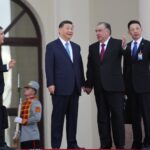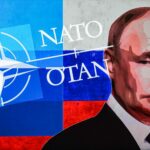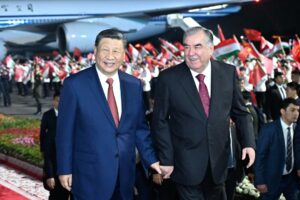President Vladimir Putin’s partial mobilisation amid battlefield setbacks, has underscored Russia’s need for increased manpower for its military campaign in Ukraine. That makes the country’s recruitment efforts increasingly central. While most of the new recruits and conscripts will undoubtedly be Russian nationals, a small portion may be foreigners. This international recruitment angle offers tangible advantages, but there are limitations and the arrival on the battlefield of foreign soldiers will not be a panacea.
Lessons from Ukraine’s experience of foreign fighters ought to offer some warnings for policymakers in the Kremlin. Despite early enthusiasm and with varying levels of past military experience, Ukraine’s foreign volunteers ultimately contributed very little besides some short-lived, outward-facing propaganda value. However, the Russian Federation could have some advantages over its neighbour in this respect. Many of these potential foreign fighters are already present in the country and speak Russian. Furthermore, with the winter months likely to stall or at least reduce the intensity of the fighting, Russia has at least a few months to prepare for the training and deployment of these foreign fighters, while Ukraine suffered from setbacks because of having to quickly deploy, including a high drop off rate.
Volunteers from the Near Abroad
At Russia’s disposal are two main offers: citizenship and money. Though Russian citizenship is not the most sought after in the world, it remains highly prized among Central Asians, particularly those already resident in Russia. Ongoing discrimination and exploitation of many due to their non-citizen status persists. The threat of deportation, issuance of fines, and pressure to pay bribes are just some of the challenges that face migrants, especially non-Slavic ones. As such, the ability to swap their own passport for a burgundy one remains alluring. Additionally, with most migrants being single men between the ages of twenty and thirty, they are also the ideal demographic for recruiters.
President Putin has been notable for his active encouragement of immigration from former Soviet republics, including non-Slavic majority Muslim ones, despite a major reservoir of anti-immigrant sentiments among parts of the population, notably articulated in Alexei Navalny‘s early career rhetoric. The Russian government’s push for a higher immigration rate, such as through simplification of immigration law as well as the legalisation of dual citizenship, stands in notable contrast to many other Eastern European countries with similarly declining populations. The year 2020 saw more than 225,000 new Russians from across the former Soviet Union excluding Ukraine, while in 2021 roughly 185,000 people from Tajikistan, Kazakhstan, and Uzbekistan alone obtained Russian citizenship.
In the case of the Russian Federation, this has already taken a military form. Since 2015, foreign nationals between the ages of eighteen and thirty have been able to join the Russian military, though this was mainly aimed at former Soviet republics, as evidenced by the Russian language enlisting requirement. On 20 September 2022, the Duma shifted enlistment conditions to make it easier and more attractive. The new bill reduced the length of the service contract to one year, after which foreign nationals «will be able to obtain citizenship of Russia under a simplified procedure without obtaining a residence permit.» That same day on the local level, Moscow’s Mayor Sergei Sobyanin announced that the city government would assist the Ministry of Defence by opening a recruitment office at the Sakharovo migration centre.
Potential salaries for military service are considerably higher than is otherwise the case for most Central Asian migrant labourers. PMC Wagner have reportedly offered 240,000 rubles ($ 4,383) per month to potential Kyrgyz employees, which stands in considerable contrast to the 2020 average monthly salary of less than 19,000 Kyrgystani Som (which in 2022 was roughly $ 237) in Kyrgyzstan itself. According to a 2021 study of Central Asians living in Russia, migrant labourers from the region earned an average of 47,100 rubles, a mere fifth of what Wagner could potentially pay. Assuming volunteers enlist into the regular forces and get the same as Russian citizens were in 2020, then foreign fighters can expect a modest but still substantial salary bump to over 62,000 rubles per month. Due to the manpower shortage, federal and local officials have been offering pay rises, ranging from higher basic salaries to sign-up bonuses.
With food and other living expenses likely to be covered during a soldier’s active service, even a reduced salary can deliver higher remittances to families. In places such as Tajikistan, over a quarter of the gross domestic product is already derived from remittances from migrant workers living in Russia, where they benefit from relatively higher wages. Though the Russian Federation has weathered sanctions better than many in the West had expected, economic stagnation could hit Central Asians living in Russia particularly hard in coming months, whereas military service may offer more financial security. Meanwhile, the second form of payment could be in the form of compensation to the families of soldiers killed, which already takes place with Russian soldiers.
Ultimately, the question of recruiting Central Asians, especially the ones not ordinarily resident in Russia, will need to be weighed up against the potential backlash from Central Asian governments. In August, the Perm-based Uzbek community leader Jahongir Jalolov publicly called for the formation of an Uzbek volunteer battalion, arguing that «We live and work in Russia. We don’t just need to, we ought to justify the bread we’re eating.» Shortly after, the Uzbek embassy in Moscow warned its citizens against participation in a foreign conflict, citing Article 154 of the country’s criminal code. Similarly, the Embassy of Kyrgyzstan referred to Article 256 of the Criminal Code of the Kyrgyz Republic and the possibility of a ten year prison sentence for those that fight abroad.
It remains unclear how Central Asian governments actually would respond if one of their citizens becomes a Russian national. Though the argument can be made that these individuals could still be subject to prosecution for having fought for Russia before their naturalisation, it will complicate bilateral relations if it is a Russian citizen who is charged. While the Russian Federation dropped the requirement to renounce one’s citizenship when naturalising, many former Soviet republics, especially in Central Asia, have not followed suit. Consequently, assuming that volunteers serve for at least one year, they are likely to visit their homelands as foreign nationals.
The response could vary widely. Those with friendlier relations, like Tajikistan, or more dependent, such as Kyrgyzstan, may choose to acquiesce, tacitly approve, or simply ignore. In March, two Kyrgyzstani-born Russian soldiers and citizens were killed in Ukraine. Shortly after, the two were buried in their hometowns in ceremonies that included both Russian and Kyrgyzstani flags and featured members of Kyrgyzstan’s National Guard. On the other hand, Uzbekistan and Kazakhstan are better positioned, and perhaps more willing, to oppose the involvement of their citizens as well as resist pressure from the Kremlin. A decisive factor may also be the question of scale. If Central Asians wearing Russian uniforms becomes a mass phenomenon, a reaction becomes more likely. However, if numbers are small and recruitment is largely limited to within the Russian Federation, then it becomes more probable that governments in the region will be more muted in their response.
Longstanding Allies
Syria could be one potential source for volunteers, which comes with several advantages. Syrian soldiers, as a result of their own eleven year long war, are among the world’s most battle hardened warriors. Additionally, many already have experience fighting in coordination with the Russian military, ranging from urban warfare to joint air-ground operations and beyond. Should they be recruited in their own country, the formation of all-Syrian battalions could offer the benefit of better unit cohesion, unlike the multinational alternatives that often appear in foreign fighter-involved conflicts seen elsewhere.
Despite these advantages, serious challenges lie ahead, should Moscow be serious about this option. The vast majority do not speak Russian, though this could be resolved through the use of interpreters. More burdensome is the fact that many may be risk-averse, especially when fighting for a foreign state. Additionally, Russian officers have not always had a positive impression of Syrian soldiers. General Alexander Dvornikov, who commanded Russia’s Syria campaign, noted the high levels of demoralisation within the Syrian Arab Army. This does not make the task impossible. The Russian military has already shown itself capable of creating effective Syrian units, such as the 5th Volunteer Assault Corps. Nevertheless, the track record in the Middle Eastern country may leave some commanders wary. On multiple occasions, Russia resorted to relying on the Wagner Group to protect oil and gas fields instead of depending on Syrian troops, some of whom had even stolen Russian equipment.
Furthermore, with the war in Syria still ongoing, large-scale recruitment could deplete Damascus of its best soldiers. On the other hand, if recent reports of a potential renormalisation of relations with Turkey are accurate, the Syrian Arab Army could have more room to manoeuvre. If that transpires, and recruitment in Syria becomes a reality, then the Kremlin can afford to sustain higher casualty rates without risking domestic political backlash.
From an economic perspective, Syrian troops could be cheaper too. If recruitment is targeted to those with experience, then less trainingis needed (if any). The dismal state of the war torn country’s economy and the large number of Syrian troops, whether part of the regular forces or one of the many pro-government militias, could prove a potent mix. Russian salaries would go far in a country where over ninety percent of the population lives under the poverty line. Furthermore, the Russian military could offer compensation rates, including in case of deaths, that are lower than those given to Russian nationals while still large by Syrian standards. However, this runs the risk of creating tensions between potential Syrian volunteers and their Russian counterparts.
Despite the potential viability of Syrian fighters, they have so far not materialised. In March, Russian Defence Minister Sergei Shoigu suggested that upwards of sixteen thousand volunteers from the Middle East could be deployed to Ukraine. Half a year later, none have been sighted. It is possible that the suggestion was merely intended to serve a psychological purpose rather than being an actual option. With a greater need for soldiers, particularly experienced ones, this could finally become a reality.
A more remote possibility would be the deployment of North Korean troops. Pyongyang has been one of the few countries to explicitly support its northern neighbour’s military campaign, at least rhetorically as well as symbolically, such as through the recognition of the Donetsk and Luhansk People’s Republics. North Korea also has a history of close military-to-military cooperation with a select number of countries, mainly Russian allies. Syria, for example, has received considerable military support, primarily in the form of materiel such as ballistic missiles During the summer, some Russian media outlets even raised the possibility of North Korean involvement in a military capacity as well as reconstruction efforts in the Donbass, though Russian Foreign Ministry Deputy Spokesman Ivan Nechayev quickly dismissed the claims of direct military participation as «fake news.» While scepticism may be warranted, North Koreans have not yet gotten involved.
Participation in an interstate conflict may prove to be too far for the northeast Asian martial state, having even publicly denied being willing to furnish Russia with munitions. Russia is host to thousands of North Korean migrant labourers. Unlike Central Asian migrants, however, their presence in Russia has been directly facilitated by their government so are therefore unlikely to enlist without the blessing of Pyongyang, which remains primarily focused on its own security position vis-à-vis its neighbours and the United States. The North Koreans living in Russia, some of whom reportedly are still soldiers, serve as a crucial source of hard currency for the North Korean government, thereby making them far more lucrative as labourers than soldiers. Plus, many migrant labourers do not necessarily have substantive military experience, especially when contrasted with their compatriots serving in the armed forces of North Korea’s highly militarised state, but rather serve as an outreach between the two neighbours and as a crucial source of hard currency.
Other Options
Further afield, potential recruits could be found. In Ethiopia, following online circulation of false rumours of Russian recruitment, hundreds of Ethiopians, including many veterans, lined up outside the Russian Embassy in Addis Ababa, though there is no evidence that they were accepted. In the Sahel, numerous governments have warmly embraced Russian security personnel and closer ties with Moscow. On the other hand, the continued instability in these countries make them unreliable recruitment grounds as well as would run the risk of complicating Moscow’s joint counterterrorism and counterinsurgency efforts in the region, especially since it has reportedly already had to withdraw some of its own forces in order to fight in Europe. Across the African continent, where pro-Russian sympathies remain considerable, governments may want to continue to pursue a policy of neutrality, while preventing the recruitment of their citizens. Numerous countries, such as Algeria, Senegal, and South Africa, already halted Ukrainian efforts so may wish to replicate this policy, especially in the face of continued Western pressure to decouple Russia from its African allies and sympathisers.
Russia’s release of captured pro-Ukrainian foreign fighters, despite many having received death sentences by the Donetsk People’s Republic, along with its own open call for enlistment of foreign nationals, suggests the Kremlin has changed its tune on foreign volunteers. The international nature of the conflict, with Moscow stating it is at war with NATO while Kyiv claims to be de facto member of the alliance, means the Russian government is no longer shy about openly involving foreign nationals.
So the demographics of soldiers deployed by the Russian Federation may change in the coming months. Russian-speakers can be sent to pre-existing units to fill shortages while those who do not speak the language could be assembled into ethnicity or nationality-based battalions. If the will is there, several thousands can be recruited. However, without a fundamental push, in the end the bulk of new Russian soldiers will remain Russian.















